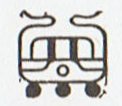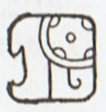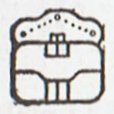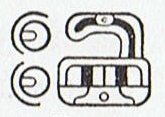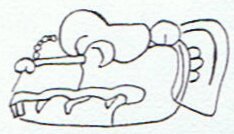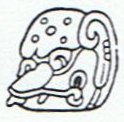|
TRANSLATIONS
We are not yet finished with the black 4th quarter according to the Mayan calandar. There is a question mark at the 18th and last of the regular (i.e. ordered as if by a king - rex) months, Cumhu:
The glyph obviously has a top and a bottom part. The bottom part is the well-known glyph for maize, or to be more precize: the glyph of the 4th day, Kan. Maybe, I think, the 4th quarter and the 4th day coincide on purpose.
In the presumed 'cognate' Aa1-14 I have earlier guessed marai has some connection with marae:
By my 'free' translation marai should mean mara-î = full of (the mother of all) cultivated fields:
From this I venture where Kelley does not (though I am using his text): "Occasionally in Maya texts we have references to 'earth-center', in a cosmological and directional sense. In the Chumayel (R. Roys 1933, Maya text p. 32, translation p. 100) a directional series is given, omitting the red ceiba tree of the east and replacing it by a green ceiba 'in the center (of the world)'. In 1889, Seler had pointed out what seemed to be a series of five directions in which the cab 'earth' glyph appeared, with the associated color yax 'green'. He suggested a meaning of 'center, vertical, up or down'. This seems entirely valid. In the Dresden and, more rarely, in the Madrid, the cab glyph is found followed by T663 [unfortunately not shown in the book of Kelley]. Knozorov (1967, no. 155, p. 92) read T663 as tan 'middle', apparently without cosmic implications. However, tan would normally be prefixed to cab rather than suffixed. Thompson (1950, p. 271) read the glyph as pakal 'seed', partly because of a frequent agricultural context, partly because of the association with the cab 'earth' glyph, and partly because of agricultural associations of some associated glyphs. However, the combination appears in no less than three of the picture sections of the Dresden eclipse table, and its other associations seem to me more cosmological than agricultural. I think that the associated 'agricultural' glyphs are found because of their grammatical meanings rather than their agricultural connotations, and the agricultural context, when valid, probably refers to ceremonial or divinatory associations. The Maya term which Roys translates 'in the center' is tu chumuc. The Evreinov, Kosarev, and Ustinov catalog (1961b, III, 153-155, no. 175) shows that the cab-T663 combination appears with ti 'at' prefixed, with the locative read by Thompson as yol 'in' prefixed, and with tu prefixed in the form without crosshatching. The tu prefix with crosshatching appears with T663, without cab. This latter use would seem to correspond fully with the cited tu chumuc. Without either a demonstrated homonymic use or known cognates in other Mayan languages, a suggestion that T663 should be read chumuc must be very tentative but, I think, is preferable to either pakal or tan." I guess cumhu (cumku) is a word closely associated with chumuc, both in form and meaning - being the pito of the world. The world revolves around food and what is fruitful. The new world (ceiba) is green (yax): ... Now do I see / the Earth anew / Rise all green / from the waves again ... / Then fields unsowed / bear ripened fruit / All ills grow better ...
|
|||||||||||||||||||||||||||||||||||||||||||||||||||
